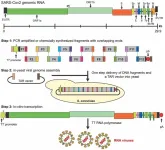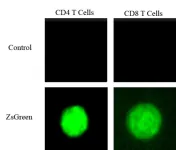(Press-News.org) Since the Centers for Medicare and Medicaid Services launched the Acute Hospital Care at Home (AHCaH) Waiver in 2020, thousands of patients from across 300 hospitals in 37 states have been treated in their homes. Yet little is understood about these patients’ outcomes on a national level, and the waiver will end in December 2024 unless there is an act from Congress. A new study by investigators from Mass General Brigham analyzed outcomes from AHCaH for a diverse group of patients across America. The study provides preliminary evidence suggesting that home hospital is an important care model for managing acute illness, including among socially vulnerable and medically complex patients. Results are published in a research letter in Annals of Internal Medicine.
“For hundreds of years, since the inception of hospitals, we’ve told patients to go to a hospital to get acute medical care. But in the last 40 years, there’s been a global movement to bring care back to the home,” said corresponding author David Michael Levine, MD, MPH, MA, clinical director for research and development for Mass General Brigham’s Healthcare at Home. “We wanted to conduct this national analysis so there would be more data for policymakers and clinicians to make an informed decision about extending or even permanently approving the waiver to extend opportunities for patients to receive care in the comfort of home.”
Advances in healthcare technology have made it more possible than ever to offer treatment options to patients in their home rather than requiring office or hospital visits. Mass General Brigham is a recognized leader in acute hospital care at home, with a Home Hospital program that serves 66 neighborhoods across greater Boston. In addition, Levine and other investigators from across Mass General Brigham are conducting rigorous, national-level research to present data relevant to clinicians, patients, caregivers and policymakers to inform decisions about the acute hospital care at home model.
Levine and colleagues looked at clinical characteristics and outcomes from all of the 5,858 patients from across the U.S. who were cared for under the AHCaH Waiver, using Medicare fee-for-service Part A claims filed between July 1 2022 and June 30 2023. Then they studied whether these clinical characteristics varied across different demographic groups.
Fifty-four percent of the patients were female, 85.2 percent were white, 61.8 percent were over 75 years old, and 18.1 percent were disabled. The mean household income was $83,932.
When the team studied hospitalizations among all these patients, they found a 0.5 percent mortality rate and 6.2 percent escalation rate (returning to the hospital for at least 24 hours). In addition, within 30 days of discharge, 2.6 percent of patients used a skilled nursing facility, 3.2 percent died, and 15.6 percent were readmitted.
“Home hospital care appears quite safe and of high quality from decades of research — you live longer, get readmitted less often, and have fewer adverse events.” Levine says. “If people had the opportunity to give this to their mom, their dad, their brother, their sister … they should.”
The patients included in the current study had medically complex conditions, including 42.5 percent with heart failure, 43.3 percent with chronic obstructive pulmonary disease, 22.1 percent with cancer, and 16.1 percent with dementia. The five most common discharge diagnoses were heart failure, respiratory infection (including COVID), sepsis, kidney/urinary tract infections, and cellulitis.
“There are a number of reasons we think hospital-level care is better at home,” Levine said. “For one, the discharge process is smoother since we show patients how to take care of themselves right in their homes, where they are also more likely to be upright and move more. In addition, the clinical team has a greater ability to educate and act on the social determinants of health that we see in the home. For example, we can discuss a patient’s diet right in the kitchen or link a patient with resources when we see the cupboards are bare.”
The outcomes were also stratified by patients of Black and Latine race and ethnicity, dual-eligible status, and by disability status. The findings were consistent across all groups.
“It was reassuring to see that there were not clinically meaningful differences in outcomes across marginalized populations, because we know that there are massive disparities in outcomes for traditional hospitalization,” Levine said. “This suggests home hospital can really reach a diverse group of patients and families.”
Still, the findings are limited to observational data, and additional research is necessary to compare the measured outcomes to those at brick-and-mortar hospitals. Levine’s team is also currently studying home hospital care for rural patients, who were not well represented in the current study.
"For decades, home hospital care has been offered all around the world,” Levine said. “This is an important moment in the United States where we might see a paradigm shift in how we deliver a sizeable portion of health care.”
Authorship: Additional authors include Jeffrey Souza, Jeffrey Schnipper (BWH), Thomas Tsai (BWH), Bruce Leff, and Bruce Landon.
Disclosures: Levine reports a PI-initiated grant and co-development from Biofourmis as well as fees from The MetroHealth System. Leff reports affiliations with Medically Home, Dispatch Health, Chartis Health and Kenes. Landon reports grants from the Agency for Healthcare Research and Quality (AHRQ) and the National Institute on Aging (NIA).
Funding: NIH Funding 5P01AG032952-13.
Paper cited: Levine, DM et al. “Acute Hospital Care at Home in The United States: The Early National Experience” Annals DOI: 10.7326/M23-2264
For More Information:
Mass General Brigham Home Hospital
Mass General Brigham to Expand Home Hospital to 3 Community Sites
###
About Mass General Brigham
Mass General Brigham is an integrated academic health care system, uniting great minds to solve the hardest problems in medicine for our communities and the world. Mass General Brigham connects a full continuum of care across a system of academic medical centers, community and specialty hospitals, a health insurance plan, physician networks, community health centers, home care, and long-term care services. Mass General Brigham is a nonprofit organization committed to patient care, research, teaching, and service to the community. In addition, Mass General Brigham is one of the nation’s leading biomedical research organizations with several Harvard Medical School teaching hospitals. For more information, please visit massgeneralbrigham.org.
END
Embargoed for release until 5:00 p.m. ET on Monday 8 January 2024
Annals of Internal Medicine Tip Sheet
@Annalsofim
Below please find summaries of new articles that will be published in the next issue of Annals of Internal Medicine. The summaries are not intended to substitute for the full articles as a source of information. This information is under strict embargo and by taking it into possession, media representatives are committing to the terms of the embargo not only on their ...
Children and adolescents who received one of the main COVID-19 vaccines were significantly protected from the illness and showed no increased signs of cardiac complications compared to young people who were not vaccinated, according to a new real-world study led by researchers from the Perelman School of Medicine at the University of Pennsylvania and Children’s Hospital of Philadelphia (CHOP). When the Delta variant rose to prominence, the study showed that vaccinated young people were 98 percent less likely to be infected than their unvaccinated peers, and ...
Research is shedding light and potentially expanding options for patients living with Medulloblastoma, an aggressive childhood cancer.
Medulloblastoma is a cancer impacting both very young and school aged children.
When children get this type of brain tumor, they experience the process of the tumor blocking flow of fluid around the brain.
This can cause severe headaches, vomiting, sleepiness, fussiness, and difficulty walking and coordinating movements.
Treatment is intense, involving high dose chemotherapy, surgery, and sometimes radiation or stem cell transplants.
During these months long treatments, children may lose ...
Despite an alarming increase in overdose deaths among young people nationwide, a new “secret shopper”-style study led by Oregon Health & Science University researchers finds that access to residential addiction treatment centers for adolescents in the United States is limited and costly.
The study, published today in the January issue of the journal Health Affairs, found that about half of the sites reported a wait time, and among those the average wait was almost a month. For those who do manage to find a placement, the average daily cost is $878 — with close to half of the facilities that provided information requiring partial or full payment upfront. For the average ...
Access to residential addiction treatment centers caring for U.S. adolescents under 18 years old in the United States is limited and costly, according to a new study supported by the National Institutes of Health. Researchers found that only about half (54%) of the residential addiction treatment facilities that they contacted had a bed immediately available, and for those that had a waitlist, the average estimated time before a bed opened was 28 days. In addition, the average daily cost per day of treatment was $878, with close to half (48%) of the facilities that provided information requiring partial or full payment upfront. ...
“TAR cloning is used to genetically engineer synthetic viruses with novel properties that may be used for the development of new vaccines.”
BUFFALO, NY- January 8, 2024 – A new review paper was published in Oncotarget's Volume 14 on December 22, 2023, entitled, “Transformation-associated recombination (TAR) cloning and its applications for gene function; genome architecture and evolution; biotechnology and biomedicine.”
Transformation-associated recombination (TAR) cloning represents a unique tool to selectively and efficiently recover a given chromosomal segment up to several hundred ...
UNIVERSITY PARK, Pa. — Mobile phones pack a lot of information into pocket-sized devices, which is why users may want to slow down the next time they’re scrolling through social media or checking email on a mobile app. People process information more efficiently but tend to be less vigilant about misinformation on their mobile phones compared to personal computers (PCs), according to a team led by Penn State researchers. This is especially true for users who have developed a routine or habit of using their ...
AMHERST, Mass. – In a first-of-its-kind research breakthrough, a team of scientists at the University of Massachusetts Amherst has analyzed and described what they call the “mosquito effect,” which sheds light on how certain pathogens, such as cancerous tumor cells, can outwit the body’s immune system.
Just as mosquitoes ingest their host’s blood, the immune system’s T cells incorporate cytoplasmic material from tumors into their own cytoplasm. While it has long been known that many kinds of cells can transfer cellular material from one to another, the transfer of the cytoplasm has never been observed in T cells. Subsequent single-cell RNA (scRNA) ...
Researchers have developed a new soft robot design that engages in three simultaneous behaviors: rolling forward, spinning like a record,and following a path that orbits around a central point. The device, which operates without human or computer control, holds promise for developing soft robotic devices that can be used to navigate and map unknown environments.
The new soft robots are called twisted ringbots. They are made of ribbon-like liquid crystal elastomers that are twisted – like a rotini ...
In recent years, there has been rising concern that tiny particles known as microplastics are showing up basically everywhere on Earth, from polar ice to soil, drinking water and food. Formed when plastics break down into progressively smaller bits, these particles are being consumed by humans and other creatures, with unknown potential health and ecosystem effects. One big focus of research: bottled water, which has been shown to contain tens of thousands of identifiable fragments in each container.
Now, using newly refined technology, researchers have entered a whole ...




